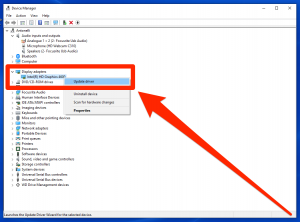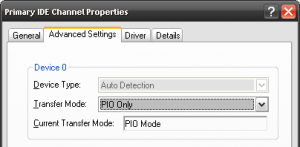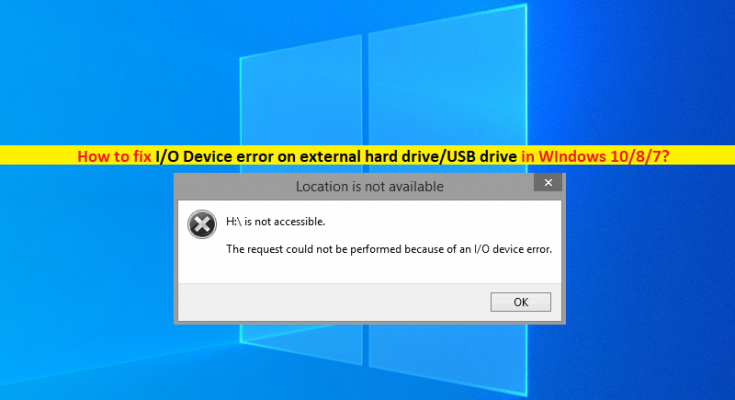Tips to fix I/O Device error on external hard drive/USB drive in Windows 10/8/7:
In this post, we are going to discuss on “How to fix I/O Device error on external hard drive/USB drive in Windows 10/8/7”. You will be guided here with easy steps/methods to resolve the issue. Let’s starts the discussion.
‘I/O Device error’: It is common Windows Problem considered as I/O Device error usually occurred while performing read/write operations on your external storage media like USB flash drive, SD cards, memory cards, pen drives, external hard drives, etc. This error usually when you try to access files/folders stored in external hard drives/USB drives attached into your Windows 10/8/7 computer.
When you try to access files/folders in external hard drives/USB flash drives, then you will get sometimes ‘I/O Device error’ saying ‘The request could be performed because of I/O device error’. This error is appeared with ‘Location is not available’ title. The possible reasons behind this error can be the plugged storage device that is incorrectly connected and PC cannot detected your connected device normally.
This error can also be appeared when your computer USB port or USB card reader is damaged/broken. Outdated computer storage device driver or it is damaged or incompatible with your attached device. Also, this error can be occurred if your storage device is recognised with wrong drive letter or it is dirty or damaged, and/or when Windows is trying to use transfer mode that hardware device can’t use. Let’s go for the solution.
How to fix I/O Device error on external hard drive/USB drive in Windows 10/8/7?
Method 1: fix I/O Device error on external hard drive/USB drive with ‘PC Repair Tool’
‘PC Repair Tool’ is easy & quick way to find and fix BSOD errors, DLL errors, EXE errors, problems with programs/applications, malware or viruses issues, system files or registry issues, and other system issues with just few clicks. You can get this tool through button/link below.
Method 2: Update Windows drivers

Updating all necessary Windows drivers to latest update can resolve the error. Let’s try. You can try to get latest update for all Windows drivers using Automatic Driver Update Tool and you can get this tool through button/link below.
Method 3: Change Drive Letter

This issue can be occurred due to wrong drive letter of your storage device that is causing error and unable to function in computer. You can change drive letter to fix the issue.
Step 1: Open ‘Disk Management’ in Windows PC via Windows Search, find and right-click on your USB drive/external drive, and select ‘Change Drive Letter and path…’
Step 2: In the opened window, select your drive and click ‘Change’ button, select ‘drive letter’ from dropdown and hit ‘Ok’ and ‘OK’ again to save the changes. Once done, restart your computer and check if the error is resolved.
Method 4: Check all cable connections
You should make sure there is no issue with storage device cable and cords. You can fix the issue by disconnecting external hard drive/USB drive from the port and try connecting to another port in order to check if cable or port is problematic or not, and check if it works for you.
Method 5: Check all cords
When the electricity in one set of wires tends to lead into another set of cables, then it might interface when you perform I/O operations. To resolve the issue, disconnect all additional devices except your extern anal drive/USB drive on your computer and connect only those cords of necessary tools. You can fix the issue permanently by replacing the current wires with better cables.
Method 6: Change the drive transfer mode in IDE channel properties

Windows OS can’t transfer data from drive to computer if transfer mode is incorrect, you can change transfer mode in order to fix the issue.
Step 1: Open ‘Device Manager’ in Windows PC via Windows Search Box and expand ‘IDE ATA/ATAPI Controllers’
Step 2: Right-click on the channel form list of IDE ATA/ATAPI channels, where appropriate drive is connected, and select ‘Properties’
Step 3: In ‘Properties’ window, click on ‘Advanced Settings’ tab and select ‘PIO Only’ in Transfer Mode box for the device that represents appropriate drive. This is Device 0. Click on ‘OK’ and close all windows
Step 4: Once done, please check if the issue is resolved
Method 7: Check and repair the storage device using Command Prompt
Step 1: Type ‘cmd’ in Windows Search Box and press ‘SHIFT + ENTER’ keys on keyboard to open ‘Command Prompt as Administrator’
Step 2: Type ‘chkdsk G: /f /r /x’ command and hit ‘Enter’ key to execute. Here, you can replace ‘G’ with your storage device drive letter and once done, please check if the error is resolved.
Conclusion
I am sure this post helped you on How to fix I/O Device error on external hard drive/USB drive in Windows 10/8/7 with several easy steps/methods. You can read & follow our instructions to do so. That’s all. For any suggestions or queries, please write on comment box below.



